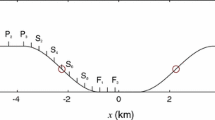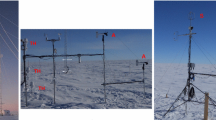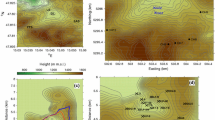Summary
The thermal regime in the moist surficial peat layer of a palsa, measured during a clear and calm July day in arctic Alaska, indicates that coupled heat and water flow retard ablation of the ice core. A simulation model of coupled-flow effects was constructed using rough estimates of meteorological boundary conditions and material properties. The model indicates that ablation is inhibited by advection of cold water above the ice/peat interface, and by internal evaporation near the surface. Evaporation also limits thermal maxima near the surface; because the ratio of the heat of evaporation to the heat of fusion is approximately 7.5, the coupled-flow regime effectively retards ablation of the palsa's ice core.
Zusammenfassung
Das Temperaturregime in der feuchten, oberflächennahen Torfschicht eines Pals wurde während eines klaren und windstillen Julitages in der Arktis von Alaska vermessen. Es wird gezeigt, daß der gekoppelte Wärme- und Wasserstrom die Ablation des Eiskernes verzögert. Ein Simulationsmodell der gekoppelten Stromeffekte wurde konstruiert, wobei grobe Abschätzungen der meteorologischen Grenzbedingungen und der Bodenbeschaffenheit angebracht wurden. Das Modell deutet an, daß die Ablation durch Advektion von kaltem Wasser oberhalb der Eis-Torf-Grenzschicht und durch interne Verdunstung nahe der Oberfläche behindert wird. Verdunstung beschränkt außerdem die Temperaturmaxima nahe der Oberfläche. Da das Verhältnis der latenten Wärmen der Verdunstung und der Sublimation ungefähr 7,5 beträgt, verzögert das gekoppelte Stromregime effektiv die Ablation des Eiskernes der Pals.
Similar content being viewed by others
References
Hillel, D.: Soil and Water. New York: Academic Press 1971.
Kersten, M. S.: Thermal Properties of Soils. Bulletin 29, Engineering Experiment Station, Institute of Technology, University of Minnesota, 1949.
Nelson, F. E., Outcalt, S. I., Goodwin, C. W., Hinkel, K. M.: Diurnal Thermal Regime in a Peat-Covered Palsa, Toolik Lake, Alaska. Arctic (in press).
Outcalt, S.: The Effects of Iteration Frequency on a Model of Ice Segregation. Engineering Geology13, 111–124 (1979).
Rose, C. W.: Agricultural Physics. London: Pergamon Press 1969.
Sturges, D. L.: Hydrologic Properties of Peat from a Wyoming Mountain Bog. Soil Science106, 262–264 (1968).
Thie, J.: Distribution and Thawing of Permafrost in the Southern Part of the Discontinuous Zone in Manitoba. Arctic27, 189–200 (1974).
Zoltai, S. C.: Southern Limit of Permafrost Features in Peat Landforms, Manitoba and Saskatchewan. Geological Association of Canada, Special Paper9, 305–310 (1971).
Author information
Authors and Affiliations
Additional information
With 6 Figures
Rights and permissions
About this article
Cite this article
Outcalt, S., Nelson, F. A model of near-surface coupled-flow effects on the diurnal thermal regime of a peat-covered palsa. Arch. Met. Geoph. Biocl. A. 33, 345–354 (1985). https://doi.org/10.1007/BF02258484
Received:
Issue Date:
DOI: https://doi.org/10.1007/BF02258484




